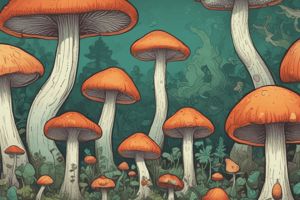Podcast
Questions and Answers
What is the primary mode of transmission of Coccidioides immitis?
What is the primary mode of transmission of Coccidioides immitis?
- Through vector-borne transmission
- Through ingestion of contaminated food
- Through inhalation of arthroconidia (correct)
- Through skin contact
Which of the following groups is most commonly affected by Blastomycosis?
Which of the following groups is most commonly affected by Blastomycosis?
- Men between the ages of 40 and 60 years
- Men between the ages of 20 and 40 years (correct)
- Children under the age of 10 years
- Women between the ages of 20 and 40 years
What is the common name for coccidioidomycosis?
What is the common name for coccidioidomycosis?
- Desert Fever
- Valley Fever (correct)
- California Fever
- San Joaquin Fever
Which of the following is NOT a characteristic of Cryptococcus neoformans?
Which of the following is NOT a characteristic of Cryptococcus neoformans?
What is the main difference between the yeast and hyphal forms of Candida albicans?
What is the main difference between the yeast and hyphal forms of Candida albicans?
What is the primary site of infection for Pneumocystis jiroveci?
What is the primary site of infection for Pneumocystis jiroveci?
Which of the following fungi is NOT an opportunistic mycotic pathogen?
Which of the following fungi is NOT an opportunistic mycotic pathogen?
What is the term for the warty patches surrounded by tiny painless abscesses seen in blastomycosis?
What is the term for the warty patches surrounded by tiny painless abscesses seen in blastomycosis?
What is the term for the fungal outer wall that prevents phagocytosis?
What is the term for the fungal outer wall that prevents phagocytosis?
Which of the following is a characteristic of Aspergillus fumigatus?
Which of the following is a characteristic of Aspergillus fumigatus?
What is the method of reproduction in yeast cells?
What is the method of reproduction in yeast cells?
What is the characteristic feature of mold cells?
What is the characteristic feature of mold cells?
At what temperature do fungi typically exist as yeast?
At what temperature do fungi typically exist as yeast?
What is the primary factor that governs the incidence and spread of fungal infections?
What is the primary factor that governs the incidence and spread of fungal infections?
What is the primary mode of transmission of Histoplasma capsulatum?
What is the primary mode of transmission of Histoplasma capsulatum?
What is the typical habitat of Histoplasma capsulatum?
What is the typical habitat of Histoplasma capsulatum?
What is the percentage of residents in areas where Histoplasma capsulatum is common who test positive for exposure?
What is the percentage of residents in areas where Histoplasma capsulatum is common who test positive for exposure?
What is the treatment of choice for Histoplasmosis if necessary?
What is the treatment of choice for Histoplasmosis if necessary?
What is the result of microconidia converting to yeast form after inhalation?
What is the result of microconidia converting to yeast form after inhalation?
What group of individuals is at increased risk of Histoplasmosis infection?
What group of individuals is at increased risk of Histoplasmosis infection?
Flashcards are hidden until you start studying
Study Notes
Fungal Infections
- Coccidioidomycosis is caused by Coccidioides immitis and can be symptomatic or asymptomatic, also known as Valley Fever.
- It is restricted to certain geographical areas and occurs through inhalation of arthroconidia.
- The fungal outer wall has antiphagocytic properties, preventing elimination.
- Disseminated coccidioidomycosis can occur in patients with AIDS and those on immunosuppressive therapy.
Blastomycosis
- Blastomycosis is caused by Blastomyces dermatitidis and primarily affects the lungs.
- Spores of the fungi enter through the respiratory system and can spread through the bloodstream to affect other parts.
- Men between 20 and 40 years old are most commonly infected.
- Blastomycosis is not increased in AIDS patients.
Pneumocystis Pneumonia (PCP)
- PCP is a lethal pneumonia common in AIDS patients, caused by Pneumocystis (carinii) jiroveci.
- It is never been grown in culture, and most information comes from clinical observations.
Candida albicans
- Candida albicans is a yeast that forms pseudohyphae and hyphae when it invades tissue.
- It can cause thrush, disseminated candidiasis, and chronic mucocutaneous candidiasis.
- Transmission is rare, but can cause pneumonia, resulting in fever, coughing, difficulty breathing, and tachypnea.
- Laboratory diagnosis involves microscopic examination of tissue, revealing yeasts and pseudohyphae.
Cryptococcus neoformans
- Cryptococcus neoformans is a heavily encapsulated yeast that causes cryptococcosis, especially cryptococcal meningitis.
- It is found in soil, enriched by pigeon droppings, and transmission occurs through inhalation of airborne yeast cells.
Aspergillus fumigatus
- Aspergillus fumigatus is a mold that causes invasive aspergillosis, allergic bronchopulmonary aspergillosis, and aspergilloma (fungus ball).
- It is found in soil and transmission occurs through inhalation of airborne spores (conidia).
Basic Mycology
- Fungi are eukaryotic organisms that exist in two basic forms: yeasts and molds.
- Yeasts are single cells that reproduce by budding, while molds consist of long filaments of cells called hyphae and reproduce by cell division.
- Some fungi are dimorphic, existing as yeasts or molds depending on temperature.
Factors of Fungal Infection
- Two major factors govern the incidence and spread of fungal infection: ubiquity of infectious organisms and adaptive immune response.
- Immunocompromised patients are at much greater risk of fungal infection.
Histoplasmosis
- Histoplasmosis is caused by Histoplasma capsulatum and occurs in soil contaminated with bat or bird droppings.
- It is commonly found in temperate, subtropical, and tropical zones, and 50% - 90% of residents in these areas test positive for exposure.
- People who live and work in the vicinity of bat or bird droppings are at increased risk of infection.
- Amphotericin B is the treatment of choice if necessary.
Studying That Suits You
Use AI to generate personalized quizzes and flashcards to suit your learning preferences.




